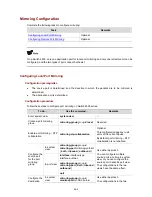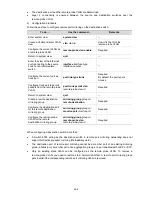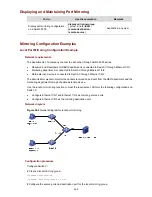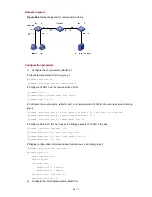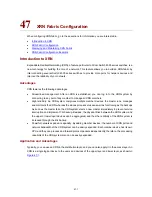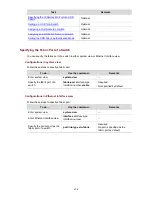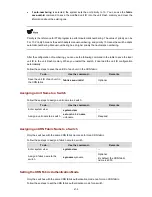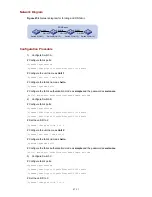
z
The destination port and the remote-probe VLAN are determined.
z
Layer 2 connectivity is ensured between the source and destination switches over the
remote-probe VLAN.
2) Configuration
procedure
Follow these steps to configure remote port mirroring on the destination switch:
To do…
Use the command…
Remarks
Enter system view
system-view
—
Create a VLAN and enter VLAN
view
vlan
vlan-id
v
lan-id
is the ID of the
remote-probe VLAN.
Configure the current VLAN as
a remote-probe VLAN
remote-probe vlan enable
Required
Return to system view
quit
—
Enter the view of the Ethernet
port connecting to the source
switch or an intermediate
switch
interface interface-type
interface-number
—
Configure the current port as
trunk port
port link-type trunk
Required
By default, the port type is
Access.
Configure trunk port to permit
packets from the remote-probe
VLAN
port trunk permit vlan
remote
-probe-
vlan-id
Required
Return to system view
quit
—
Create a remote destination
mirroring group
mirroring-group group-id
remote-destination
Required
Configure the destination port
for the remote destination
mirroring group
mirroring-group group-id
monitor-port monitor-port
Required
Configure the remote-probe
VLAN for the remote
destination mirroring group
mirroring-group group-id
remote-probe vlan
remote
-
probe
-
vlan-id
Required
When configuring a destination switch, note that:
z
A Switch 4500 acting as the destination switch in remote port mirroring networking does not
support bidirectional packet mirroring (the
both
keyword).
z
The destination port of remote port mirroring cannot be a member port of an existing mirroring
group, a fabric port, a member port of an aggregation group, or a port enabled with LACP or STP.
z
Only an existing static VLAN can be configured as the remote-probe VLAN. To remove a
remote-probe VLAN, you need to restore it to a normal VLAN first. A remote port mirroring group
gets invalid if the corresponding remote port mirroring VLAN is removed.
46-8











